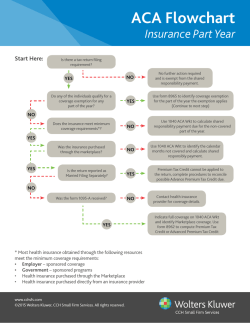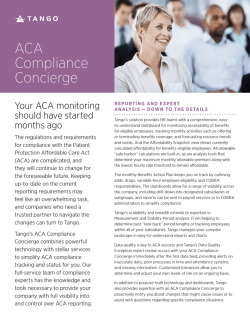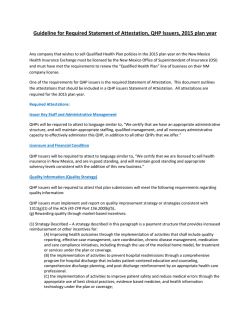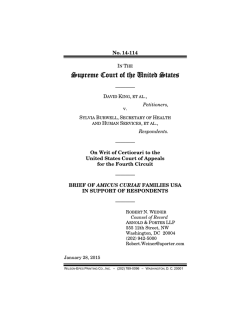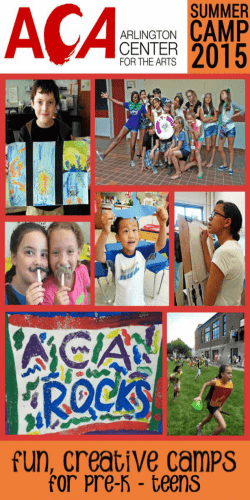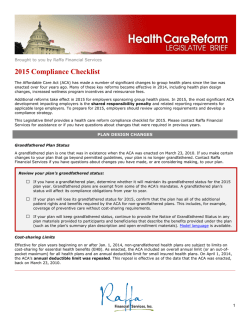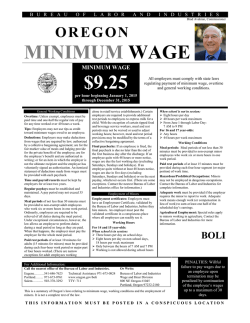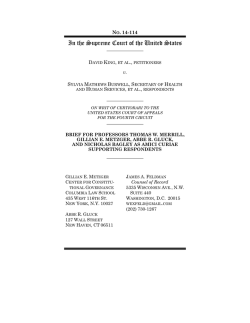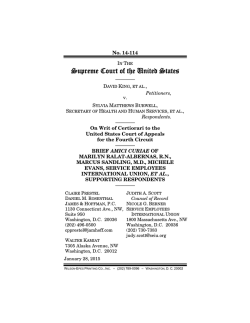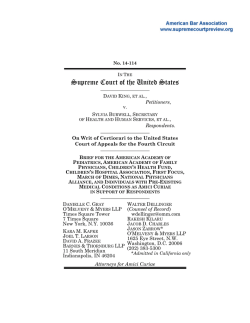
10 DAYS OF ACA
10 DAYS OF ACA Perspectives from Mercer Leadership A Year-End Article Series from Mercer/Signal: US Health Care Reform January 2015 10 DAYS OF ACA Perspectives from Mercer Leadership Introduction: Welcome to Our ‘10 Days of ACA’ Article Series Tracy Watts 1. Technology at Forefront of ACA-Driven Innovation David Kaplan 2. Why Medicaid, HIX Plans Matter to Employers Branch McNeal 3. Well-being 2.0: Employers Sharpen Focus on Workforce Health Susan Connolly 4. The Eye of the Beholder Harry Conaway 5. If ACA Is Broken, Can the GOP — and Employers — Fix It? Geoff Manville 6. Health Reform Shaking Up the Market — But Not as Expected John Larew 7. Competitive Benefits, Consumerism Drive Change Marcelo Modica 8. Key Differences in DB to DC Shift Seen on Health Side Jacques Goulet 9. ACA’s Spirit Can be Seen Unfolding Across the Globe Lorna Friedman 10. Health Benefits Still Far From a Steady State Jim McNary Conclusion: ACA Will Remain Focal Point for CEOs in 2015 and Beyond Julio Portalatin, President and CEO 10 DAYS OF ACA Perspectives from Mercer Leadership Introduction: Welcome to Our ‘10 Days of ACA’ Article Series I’m pleased to kick off of our 10 Days of ACA series. We asked a panel of experts from across Mercer to reflect on health care reform developments in 2014 and look ahead to what the ACA will bring in 2015. TRACY WATTS Tracy Watts is a Mercer senior partner and the company’s US Health Care Reform leader. Return to Table of Contents Subscribe to Mercer/Signal It’s hard to believe we have been forging through ACA compliance for more than four years. 2014 was a roller-coaster ride as we absorbed the impact of many final rules and regulations, FAQs, and court decisions addressing various aspects of ACA compliance. Here is a high-level summary of what transpired: • Final “pay or play” rules and final rules on excepted benefits. • Guidance on a 90-day waiting period added option for new-hire orientation period. • ACA employer reporting rules, forms, and draft instructions. • Annual reinsurance payment rules and fee for 2015. • Clarification on COBRA and the ACA; updated model COBRA notices. • Supreme Court allows religious relief from the contraceptive mandate. • Split court decisions on challenged ACA subsidies limited to state-run exchanges. • IRS expanded allowed cafeteria plan election changes. • Guidance on out-of-pocket maximums. • ACA minimum value plans must cover hospitalization. • Health Plan ID filing and then delay. • ACA reinsurance fee filing. More importantly, what are we expecting in 2015? Some are hoping that the change in the House and Senate as a result of midterm elections will lead to some “fixes” to the law. The most talked about changes seem to be changing from a 30-hour to a 40hour eligibility requirement and eliminating the medical device fee. We have to keep in mind that those types of changes impact funding and will require revenue from elsewhere to cover the gap, which might not be easy to find. If we turn our focus to the regulators, my top-five wish list for guidance includes the following: 1. Final ACA reporting forms and instructions. 2. R ules on minimum value of employer-sponsored coverage and an updated Health and Human Services minimum value calculator. 3. Guidance on nondiscrimination under the ACA. 4. Equal Employment Opportunity Commission guidance on wellness incentives. 5. Draft guidance and request for comments on the Cadillac tax. Lastly, we have another Supreme Court decision to look forward to in the summer of 2015 that could have a significant impact on the future of the ACA. All signs indicate that 2015 will be jam-packed with ACA activity. 10 DAYS OF ACA Perspectives from Mercer Leadership 1. Technology at Forefront of ACA-Driven Innovation The Affordable Care Act (ACA) has been both a blessing and a curse to health care innovation. DAVID KAPLAN David Kaplan, MD, is a Mercer senior partner who leads the company’s Employee Health & Benefits Innovation Hub. Return to Table of Contents Subscribe to Mercer/Signal On the plus side, it has forced employers to be more aggressive about managing their costs and improving outcomes in anticipation of the 40% excise tax on Cadillac-style health benefits slated to take effect in 2018. The issue is now more pressing than ever in this new environment, where employees are expected to make smarter choices and become better health care consumers. For many employers, however, the ACA has taken an enormous amount of energy to ensure that their health plans are in compliance. One unintended consequence is that they’re focused on nuts and bolts at the expense of innovation. But there’s also tremendous potential to move the needle in this ever-changing marketplace. Technology unlocks access to incredible amounts of information on anything from how to prepare healthy meals and where to shop for key ingredients to the most effective ways to monitor and manage chronic conditions. There also are various wellness apps and fitness trackers that help get people into shape and maintain healthy behaviors. In addition, it has never been easier to access information about the cost, quality, and value of providers when shopping for health insurance. The ACA encourages health care consumers to be more cognizant of price and open to high-deductible health plans if they happen to be an appropriate fit. Another huge trend in innovation that honors the spirit of the ACA is the emergence of patient-centered care, medical homes, and accountable care organizations — all of which promote value-based purchasing. Technology will also be at the forefront of delivering more efficient care. Telemedicine, for example, will enable patients to text or email their dermatologist photos of a suspicious rash or mole rather than schedule a face-to-face appointment. The approach could extend to the behavioral health side, with provider visits augmented by online targeted behavioral therapy, as well as teletherapy or telepsychiatry. 10 DAYS OF ACA Perspectives from Mercer Leadership 2. Why Medicaid, HIX Plans Matter to Employers At first glance, there may not seem to be much connection between the expanded Medicaid program and public health insurance exchanges and employer-provided coverage, but a closer look reveals at least two important ways employers will be affected. BRANCH McNEAL Branch McNeal is a senior partner at Mercer and National Practice leader for Government Human Services Consulting. Return to Table of Contents Subscribe to Mercer/Signal On the plus side, since payments are now being made to providers for care that used to be uncompensated or provided more on an emergency basis, the rate of medical inflation more than likely will slow down in the group market over the next several years, as compared to what it otherwise would be. At the same time, however, a flood of newly insured Americans will make access to all health care services — and particularly primary care services — more challenging, considering that the number of providers will not change much. Under the Affordable Care Act, Medicaid has now expanded in 22 states, plus the District of Columbia — with five other states pursuing alternative methods of expansion. Income eligibility for Medicaid in these states has risen to up to 138% of the federal poverty level (FPL) and is no longer restricted to certain segments of the population, such as women, children, and the disabled. This has resulted in a 10% to 20% growth in Medicaid enrollment. Layered on top of this development is the availability of a federally facilitated marketplace in 33 states, with the remainder providing state-run public health insurance exchanges. A centerpiece of this emerging marketplace is federal subsidies offered on a sliding scale even up to 400% of the FPL, which represents a major step toward making the safety net for public assistance more durable. The upshot: More than eight million individuals have signed up for exchange plans, which is a big influx of enrollees. Lower-paid workers — either part-time employees or those earning the minimum wage or close to it — have access to public assistance with health insurance if they earn less than 400% of the FPL. While employers haven’t done any significant outreach or coordination with Medicaid so far, it might be a strategy to consider. The law allows for some working Americans to have access to these benefits, and helping steer them in that direction could be good for everyone. 10 DAYS OF ACA Perspectives from Mercer Leadership 3. Well-being 2.0: Employers Sharpen Focus on Workforce Health SUSAN CONNOLLY Susan Connolly is a partner in Mercer’s Employee Health & Benefits business and US leader of the Total Health Management specialty practice. Return to Table of Contents Subscribe to Mercer/Signal As the Affordable Care Act (ACA) creates more standardization of medical benefits, employers who want to differentiate themselves as great places to work are sharpening their focus on workforce health — and changing their thinking on how to get there. In just the past few years, changes in the market, in technology, and in employee attitudes — combined with what we learned from past efforts — are pointing the way to a wellness program that may look very different from the standard program today. This new approach goes beyond what we define as wellness. It captures the essence of what drives success both inside and outside the workplace. It is well-being. This term encompasses physical, emotional, and financial health. The dimensions of wellbeing are interrelated, and by solving for the whole rather than any one of them, an employer can maximize the performance of the current and future workforce. The need to manage cost in the post-reform era — with enrollment rising and the excise tax on high-cost plans looming — has accelerated the trend toward consumerism. As employers ask workers to take more responsibility for their health spending, they need to give them the tools to succeed. While the concept gets much lip service, creating a culture that supports employee well-being requires real change management, from the CEO on down. It’s an initiative that cuts across business functions, policies, and programs, and requires the support of all HR and business leaders as well as marketing and public relations resources. The success of any one program aimed at improving employee well-being will be limited by the extent to which a healthy climate exists within the organization. The ACA supports the use of financial incentives to reward nontobacco use and health status. But incentives are only one way to promote behavior change — and may not be the most effective way. Behavioral economics provide important insights into why and how people do what they do. Consider that the size of the incentive matters far less than how it is framed and messaged. For example, research has shown that a relatively modest financial incentive delivered in the form of a gift card or lottery ticket is more effective than a bigger incentive hidden inside the paycheck. Game mechanics motivate by tapping into the desire to win without any financial incentives. Taking a broader view of the value of employee well-being makes it clear why employers will need to stay involved with employee well-being, whether they continue to administer an employee health plan, shift to a private benefit exchange, or even exit health plan sponsorship entirely. When employees thrive, businesses win. It’s that simple. 10 DAYS OF ACA Perspectives from Mercer Leadership 4. The Eye of the Beholder On the Affordable Care Act (ACA), we’re arguing about not only the expansion of Medicaid, the employer and individual mandates, and the Cadillac tax, but also the proper roles of the federal government, the states, employers, individuals, and other players in the US health care system. We’re arguing about US fiscal, tax, health care, economic, and social policies — and about our values, and whether the ACA reflects them, or doesn’t. HARRY CONAWAY Harry Conaway, a Mercer partner, leads the company’s Washington Resource Group. Return to Table of Contents Subscribe to Mercer/Signal Many different policy questions deserve consideration: • How does the ACA affect the balance between federal and state responsibilities? • How does the ACA affect the federal deficit now and in the long term? How does it affect long-term health care costs? • How might we restructure current federal and state health care expenditures via Medicare, Medicaid, the tax laws, and other programs to improve their effectiveness? What about expenditures by employers, individuals, and their families, and other stakeholders? • How does the ACA affect the competitiveness of certain companies or the US? Will it level the playing field for individuals who work for employers that provide health coverage and individuals who don’t? How about the cost of labor? Worker job lock and mobility? • How does the ACA affect the US middle class, economic inequality, and economic opportunity? • How does the ACA affect access to and delivery of health care services? Health care coverage? Does it promote health care quality? Does it reduce waste? Does it improve individual health management and wellness? Does it alter the roles of health care providers and those paying for health care? Does it affect how we pay for health care services? • How does the ACA affect the health care plan marketplace — employer-based health coverage, the individual and group markets, new groups of individuals, private health care exchanges? Of course, the ACA is not a single payer system, and it’s not Medicare for all — although specific aspects may reflect those approaches. On the other hand, the ACA clearly limits some of the flexibility that providers, insurers, employers, individuals, and other stakeholders previously had. Is this intervention in the market justified by important policy goals? Should we take governmental steps like those in the ACA to extend minimum levels of health care coverage to more Americans? When is it preferable to prioritize the community or group in the health care area? Does extending health coverage (particularly with government subsidies) support or undercut incentives to work or, more philosophically, human rights, individual freedom, or human dignity? Of course, “yes” and “no” are both reasonable answers to most if not all of the questions above — the ACA is not just one thing or the other. Over the next several years, as we consider changes to the ACA — the status quo is not a viable option — it’s essential to examine the empirical evidence, fairly describe the implications and pros and cons, recognize the tradeoffs, and accept that neither embracing nor repealing today’s ACA is the best solution. And acknowledge that sometimes we adopt laws for good reasons not well measured by financial yardsticks. 10 DAYS OF ACA Perspectives from Mercer Leadership 5. If the ACA Is Broken, Can the GOP — and Employers — Fix It? GEOFF MANVILLE Geoff Manville, a Mercer partner, leads the company’s Government Relations team. Return to Table of Contents Subscribe to Mercer/Signal While Republicans will control both chambers in the 114th Congress that convenes in January, there’s not much they can do to seriously weaken the Affordable Care Act (ACA) over the next two years without a filibuster-proof Senate majority and President Obama wielding a veto pen. The fate of the law now lies — again — across the street from the Capitol at the Supreme Court, where an expected decision in June (King v. Burwell) could strike down federal subsidies in the 36 states where the federal government runs the exchanges. That would certainly bring cheers from Republicans, but probably not for long. The resulting mess would force party leaders to confront the contentious question within their ranks of whether to try to “fix” the law or let its problems grow. In order to appeal to a broader electorate and win the White House in 2016, however, Republicans may need to show that they can come together on health care solutions. To be sure, Republicans are intent on casting votes on repealing the entire law and major components such as the employer and/or individual mandate. Bipartisan interest in changing the law’s weekly definition of full-time work from 30 hours to 40 hours also will get a major push. Another issue set to get more attention is making employer-friendly legislative changes to the Cadillac excise tax on “high value” plans that goes into effect in 2018. Changes plan sponsors would like to see include eliminating or delaying the tax and/ or excluding health flexible spending accounts, health savings accounts, and health reimbursement accounts. But don’t look for much sympathy from Republicans. Many view the tax as maybe the only cost-control in the law with teeth, and finding the revenue to offset changes to the tax would be a big policy and political challenge. Changes are always possible, though, if enough employers weigh in. And the potential fallout from the King v. Burwell case may well give new impetus to these changes. If the justices invalidate subsidies in federally-run exchanges, the president will be in the position of having to do some horse-trading with Congress to deal with the immediate crisis of millions of Americans facing dramatically higher premiums. But GOP leaders acknowledge that they need to have a more comprehensive reform plan ready. Some lawmakers have begun to introduce replacement measures that would build off of some of the law’s components, such as a plan from incoming Senate Finance Committee Chairman Orrin Hatch of Utah and other key senators. It keeps some of the law’s consumer protections but would eliminate public exchanges and provide tax credits to help small employers and individuals buy coverage. And the tax credits would be funded by capping the tax exclusion for employer-provided health care benefits at 65% of the “average plan’s costs.” Would a cap on the employee tax-exclusion for employer coverage be preferable to the Cadillac tax? Let’s discuss. And let’s have a conversation about what other policy changes may be needed to support the employer-based health care system as the ACA evolves. The stakes are higher than ever, and employers’ voices will be essential to driving positive change. 10 DAYS OF ACA Perspectives from Mercer Leadership 6. Health Reform Shaking Up the Market — But Not as Expected JOHN LAREW John Larew is a principal at Oliver Wyman, a leading strategy consulting firm and a sister company to Mercer, where he heads the Office of Reform. Return to Table of Contents Subscribe to Mercer/Signal Looking back on the first year of full Affordable Care Act (ACA) implementation, one of the most notable events is one that didn’t happen: widespread “dumping” by employers to the public exchanges. When the law was passed in 2010, many saw it as a mortal blow to employer-sponsored health benefits, with some analysts predicting that as many as 35 million employees would lose employer health benefits. Those projections turned out to be wildly off base: The group market is alive and well, and in some ways stronger because of health care reform. In fact, a case can be made that reform will ultimately improve the quality of group insurance offerings as insurance issuers learn to compete for consumer attention in the individual market and import those lessons to the group segment. Certainly, the availability of federally subsidized coverage in the individual market did not lead to a rush for the exits by employer health plan sponsors, as many had predicted. It was a case of the dog that didn’t bark. Yes, the proportion of firms offering health benefits was down slightly in 2014 — but this is the continuation of a 15-year-long trend. The anecdotal accounts in the news media of small employers dropping health coverage painted a misleading picture. While the small employers prone to dumping represent a lot of companies (90% of US firms have fewer than 20 employees), they account for a comparatively small number of workers (less than 20%), and a smaller proportion of group insured. To be sure, the loss of even a small number of small group lives is concerning to health insurers, for whom the fully insured small group business is traditionally a profitable segment. But in the big picture, the impact of health care reform on small group enrollment has thus far been muted. Will that trend continue? There are a couple of caution flags. Some groups were able to renew their pre-ACA policies through 2014, and may re-evaluate at the next renewal. Some employers may have waited to see whether the post-ACA individual market is viable before trusting it to take care of their employees. We may see some further slippage as the next chapter of reform plays out. In effect, the existence of a robust individual market represents a new option for small employers and a new source of competition for insurers, who will have to work that much harder to retain profitable small groups. In any event, those employees who end up on the public exchanges will find that coverage there looks a lot like what they used to get at work. One of the effects of the ACA benefit mandates was to force a convergence between the quality and value of benefits in the individual market and the small group market. From a consumer perspective, the two have become largely interchangeable. The flip side of this convergence is that the employer group market will increasingly come to resemble the individual market in important respects. The word “consumerism” is on everyone’s lips in the health insurance world. Insurers have invested heavily in retooling and refitting their value propositions to compete in the exchange market where consumer choice is king. Innovative value propositions developed for the direct-to-consumer market will inevitably filter back into the group segment, especially as employees increasingly exercise more choice over plans on private exchanges, such as Mercer Marketplace™. As individual consumers come into focus for health insurers, they are increasingly incorporating concepts like customer lifetime value into their marketing and management decision-making. 10 DAYS OF ACA Perspectives from Mercer Leadership 7. Competitive Benefits, Consumerism Drive Change I think most HR and benefit professionals feel that offering a worthwhile benefits package is a key part of the employee value proposition. When someone joins a company, particularly one like ours, he or she is going to expect competitive benefits that are built around choice and value. It’s a responsibility that large employers are not going to outsource or abdicate anytime soon. MARCELO MODICA Marcelo Modica is a senior partner and Chief People Officer at Mercer. Return to Table of Contents Subscribe to Mercer/Signal So when it comes to Affordable Care Act (ACA) compliance, the underlying theme is really to fulfill a critical business objective with regard to talent management. Administrative challenges are significant and are ongoing. We have to explain the law to employees and keep them fully informed through thoughtful communication. And a huge issue is to ensure that IT systems will be able to accommodate ACA reporting requirements, which is an administrative nightmare. But, long term, what we’ve focused on is complying with the ACA while providing value to our employees. Like many employers, we’ve been transitioning to health care consumerism, which is a good thing and something that the ACA has helped accelerate. People know how to shop for cameras or the right vacation spot online, but they’ve struggled to do the same with health insurance coverage and wellness programs. It’s difficult to anticipate one’s health care needs in the year ahead and, as a result, pick a plan with the optimal deductible and co-pays and provider networks. While some poor coverage decisions might be unavoidable, employees eventually will get better at deciding what’s right for them. Fortunately, decision-support tools and incentives for improving health behaviors are much better than they used to be, and they appear to be driving positive change. The rise of health care consumerism is bound to result in improved health care quality and outcomes when you consider that we’re gaining better insight into doctors and the cost of their services. When consumers are fully informed, they make better decisions and will avoid being overinsured or underinsured. 10 DAYS OF ACA Perspectives from Mercer Leadership 8. Key Differences in DB to DC Shift Seen on Health Side The shift from defined benefit (DB) to defined contribution (DC) retirement plans took root years ago, with Australia, the US, the UK, and Canada leading the way in the global economy. A similar transformation is underway with health care benefits. But when you compare the retirement and health care sides, the differences are fairly sizeable. JACQUES GOULET Jacques Goulet is a senior partner and president of Retirement, Health, and Benefits at Mercer. Return to Table of Contents Subscribe to Mercer/Signal One factor driving this trend on the retirement side has been the growing financial impact of long-term pension liabilities in the face of longer life expectancies and declining interest rates. In some cases, pension liabilities are larger than the actual size of a company, which leads to additional business risks. General Motors in the US is a good example. With health care benefits, even though costs have been increasing faster than inflation, these financial liabilities aren’t recorded on balance sheets as is the case with pensions. For both the employer and employees, planning is done on a shorterterm basis. If an employee underfunds or mismanages a DC retirement account, the consequences at retirement can be serious and hard to correct. On the health care side, employees can choose to enroll in another plan at open enrollment if they miscalculated their health care needs in a given year. So the transition from DB to DC could be a little easier on the health benefits side because there’s an ability to selfcorrect as employers move forward, and the stakes for the employer aren’t quite as high. But the thinking is essentially the same, which is that the cost of a DB approach is no longer sustainable for either retirement or health care benefits. This shift places more accountability for outcomes on individuals, though that also can be seen as an opportunity to empower employee populations to make better decisions. An example for health care is wellness programs that offer premium discounts and other incentives for those who take action to improve their health. Matching contributions is an example on the retirement side. There’s a very strong need for education and guidance as employees shoulder more financial responsibility for both their retirement and health care benefits. Plan participants across the board aren’t well equipped to make some tough decisions about their benefits, and employers will need to step up their efforts in this area. 10 DAYS OF ACA Perspectives from Mercer Leadership 9. ACA’s Spirit Can Be Seen Unfolding Across the Globe LORNA FRIEDMAN Lorna Friedman, MD, is a partner in Mercer’s Global Health Management business. Return to Table of Contents Subscribe to Mercer/Signal While health care is still — mostly — local, there’s no denying that for most organizations there is a trend toward taking a global perspective on health. As public health systems absorb the strain of aging populations and health care cost inflation, regulators and employees will turn to the private sector for support. In addition, the value of health benefits in the drive for talent and productivity is being redefined due to new health issues and demographic shifts. It is no surprise that the Affordable Care Act (ACA) is just one example of regulatory activity unfolding worldwide. Employers with growing employee populations in emerging markets as well those with globally mobile employee populations are responding by implementing systems and processes that keep them ahead of the trend rather than responding to it. The US is not unique in facing escalating health care costs and pressures to reform the health care system. Global employers must comply with regulations that not only differ from one country to the next, but also are in a seemingly constant state of flux. The challenge is to craft proactive and meaningful strategies to regulatory change that focus on improving the health of employees and helping the organization better compete on an international stage. One common emerging issue in workforce health is stress. In both employee and employer surveys, stress ranks high as a source of discontent linked to low productivity and poor engagement. A number of government ministries of health in both Western Europe and Asia have taken note and made public statements regarding the need for employers to address stress in the workforce. In most locations, established EAP services, management training, and other focused worksite programs are available to help them respond. Of course, the biggest story in health for 2014 was the outbreak of the deadly Ebola virus, which served as a poignant reminder of the vulnerability of many public health systems and a warning that there are health threats to our workforce that defy country borders. Active and ongoing pandemic planning can help employers respond quickly and responsibly to cross-border health issues. There is also increasing awareness of the importance of managing noncommunicable diseases (NCDs) such as diabetes and cardiac conditions globally. The World Health Organization (WHO) estimates that 14 million people globally between the ages of 30 and 70 — prime working ages — die from NCDs, and that 85% of these deaths occur in developing countries. The WHO has released an updated report that profiles 178 countries in relation to NCDs. The report highlights the risks, prevalence, and — importantly — the capacity of existing infrastructures in each country to respond to NCDs. Although the global workforce constitutes diverse populations and cultures, collective data and experience (such as the diabetes prevention programs) are providing guidance on how to confront and prevent chronic conditions. Given the impact on productivity, employers should consider whether their employees have adequate coverage for chronic conditions through either the public system or other coverage. Just as the ACA opened the discussion of what constitutes “essential” coverage, multinational employers are recognizing that in some countries where they do business, typical coverage is inadequate for a 21st-century employee population. Examples include supplemental health plans that don’t cover vaccines or diabetes drugs, or have exclusions for certain diagnostic groups, such as those who are HIV positive or pregnant. Looking ahead, as employers seek to centralize and standardize their total-rewards philosophies in an increasingly competitive global economy, we see them beginning to adopt a more creative approach to understanding how health and health benefits play a role in recruitment and retention for a globally informed and globally mobile employee population. 10 DAYS OF ACA Perspectives from Mercer Leadership 10. Health Benefits Still Far From a Steady Since the Affordable Care Act’s passage nearly five years ago, employer-sponsored health benefits have been undergoing constant change, and the “new normal” is not yet in clear sight. This is true for nearly every link on the health care value chain: providers, payers, health plans, consultants, and brokers. Our sister company, management consulting firm Oliver Wyman, recently published a report that brilliantly describes the rapid and fundamental changes occurring in the health care industry, which of course will affect employers as well. JIM McNARY Jim McNary is a senior partner with Mercer and the North America Region Business leader for Employee Health and Benefits. Return to Table of Contents Subscribe to Mercer/Signal What may seem like an effective strategy for employers today can be quickly overcome by events. In speaking with clients, I’ve noted two implications of the pace of change. First, companies of all sizes and in all industries are keeping their options open and their eyes trained on marketplace trends. They are more interested than ever in peer-to-peer networking and are looking for help from advisors with both deep technical expertise and a broad strategic perspective. One emerging innovation that employers are watching closely is the private health benefit exchange, which will be part of evolutionary change in some organizations or a revolutionary step for others. While only 3% of employers are estimated to be using private exchanges such as the Mercer Marketplace™ now, 31% believe it’s likely they will be using an exchange within the next five years. A second notable trend is that the process of setting benefits strategy is no longer confined to the HR function. Decision-makers now include other members of the C-Suite and boards of directors. Stakeholder management and education is an increasingly important skill set, as the owners of benefit plans aim to have their internal strategies keep pace with the external environment. This will require “a strategy for the strategy” as they lay the groundwork for ongoing conversations with critical stakeholders about the available strategic levers and the circumstances under which they would execute various options. In an environment that is inherently complex, ambiguous, and uncertain, the key to success will reside in simplicity, clarity, and insight. The backdrop to all this activity is employers’ deep commitment to providing health coverage to employees. Mercer’s latest survey of US health plans found that fewer employers than ever are seriously thinking about scrapping their health benefit offerings and steering employees to the public exchanges. Instead, they’re carefully considering their options and embracing innovation. 10 DAYS OF ACA Perspectives from Mercer Leadership Conclusion: ACA Will Remain Focal Point for CEOs in 2015 and Beyond JULIO PORTALATIN Julio A. Portalatin is president and CEO of Mercer. Return to Table of Contents Subscribe to Mercer/Signal As the CEO of a large corporation, I understand the role that health care benefits play in organizational success. A business fundamental is to manage operational costs so that you can continue to provide your products and services at a price that your customers will pay, and health benefits are a significant cost that must be addressed. At the same time, health benefits are critical to our ability to attract, retain, and develop top talent. And as the CEO of a global benefit consultancy, I believe it’s critical for my peers to recognize that the Affordable Care Act (ACA) will profoundly change the health benefits employees are offered. There are many ways to respond to the ACA, but doing nothing is no longer an option. First is to recognize that the law will not go away. The Supreme Court challenges and the shift in the makeup of Congress will create bumps in the road, but even critics recognize that repealing this landmark legislation is a political hot potato, since there are now millions of people in public exchanges and many others who are benefitting from some of the more popular aspects of the ACA, such as eliminating pre-existing condition exclusions. That’s not to say that the law can’t be improved. Employers can and should play a role in the ongoing process to identify and address the problem areas. While many of the ACA’s provisions are already in place, no employer can afford to ignore the excise tax on high-cost plans approaching in 2018. There is no single solution that will work for every company. What course of action you choose will depend on your situation and, in particular, the makeup of the employee population. For example, employers with a mix of high-income and low-income employees will need to address their diverse needs. Companies that have already addressed longterm health benefit cost management — as well as the shorter-term compliance and reporting requirements — will have less to do than companies that are just getting started. The key to accomplishing corporate objectives in a changing benefits landscape is pursuing a strategy that will bend the curve on health benefit costs while remaining mindful that health benefits have a direct correlation to company loyalty and productivity. Companies that view providing health benefits as part of a longterm solution to their employees’ needs are more likely to win the talent war and outperform their competitors. 10 DAYS OF ACA Return to Table of Contents Perspectives from Mercer Leadership Sign Up Now for Mercer’s Health Care Reform Portal Are you finding it difficult to wade through the torrent of information on health care reform and determine what’s relevant to your organization? Sign up for Mercer/Signal: US Health Care Reform and you’ll stay up to date on the transforming health care environment. www.ushealthnews.mercer.com
© Copyright 2025
